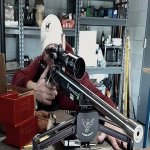Tuner work. They are in use on Olympic gun for a decade.
They are used on the most accurate guns ..Benchrest gun. Period.
The winners use tuner..so the other can yap against it..who care..when you are in the low end of scale..nobody listen to looser ways of doing things and even care less for their opinions.
Some further clarity is needed. Some ISSF shooters use extension tubes with a tuner or moveable weight, but the majority don't. Watch the video posted in a previous thread.
__________________
Tuners work. They are used on rimfire BR rifles, where their effectiveness is arguably greatest. The do not, as Matthew Good once put it, turn crap into solid gold. If anything, the Litz tuner testing showed how difficult it is to get reliable and repeatable results with a rimfire tuner.
Consider the following. When serious competitors lot test -- as do RFBR shooters and ISSF 3P shooters -- they invariably select lots that have a small ES (extreme spread). If they select a good shooting lot that has an ES of 30 fps, the maximum vertical caused by MV variation at 50 yards will be .22". That's the worse case scenario in a box of ammo. The majority of rounds in a box that has an ES of 30 fps will be much closer in MV and vertical dispersion will be even less.
Nevertheless, lots with an ES as high as 30 fps usually aren't good enough. With a better lot of match ammo with an ES of 20 fps, the maximum vertical dispersion at 50 yards will be .15". Again, that's a worse case scenario with a box of that ammo. The majority of shots in a box with an ES of 20 will be much closer in MV and vertical will again be even less.
A lot with an ES of 10 fps will experience a maximum vertical dispersion caused by MV variation of .08" or less.
How much "improvement" does a tuner have to do? On the various BR competition targets in use, a rifle with a good barrel and a well selected lot of ammo, the tuner doesn't have a great deal of room to add improvement. It does improve results for shooters who use them in the best conditions and with a good barrel and good ammo. But it doesn't cause RFBR shooters to rack up perfect scores.
To score 10's across the board in ARA, for example, requires that all shots to have an on-target ctc of .276". A 10X requires more accuracy, and this no doubt, is much more challenging. As always, even with a very good rifle, very good ammo, and a properly set tuner, it's up to the shooter to read conditions effectively.























































































